-

人教版高中英语必修2Wildlife Protection说课稿3篇
When it comes to the students’ studying methods, I'd like to introduce my Ss first. The Ss have a good command of basic language points. They’re interested in learning English, and they take an active part in English class, so they will have fun in autonomous, cooperative and inquiry learning. I will just serve as a guide, showing them the way to explore how to make more progress in their English learning.Now it’s time for the most important stage of this lesson. My teaching procedures are arranged as follows:Step1.Leading-in (3 minute)Play a video of a wide variety of wildlife to introduce my topic. Step2. Speaking (12 minutes)We will use our textbook Page25. Let the Ss fast read the short paragraph to warm up. Ask them to talk about the report on some endangered wildlife in China with the dialogue patterns on the screen. Lastly, I will invite some groups to demonstrate their dialogues about saving wildlife in China.Step3.English play (3 minutes)Watch another video in praise of their excellent performance just now. It’s about Jack Chen’s(成龙)and Yang Ziqiong’s wildlife protection.Step4. Listening (twice 13 minutes)This time, I’ll ask the Ss to fill in the blanks of the monologue of the 2 movie stars above. Step5.Discussion (3 minutes)Which would you like to choose to wear, clothes made of cotton, artificial leather or animal skins? Why ?Step6. Summary (3 minutes)1. If there were no wildlife, there wouldn’t exist human beings. If the buying stops, the killing can, too.2. Animals are our friends. To love animals is to love ourselves. Stop hunting, killing and destroying wildlife.3. Let’s live in harmony with all the living things in the world. Step7. Music appreciation (3 minutes)Let the Ss appreciate the song Earth Song by Michael Jackson. Last but not the least, I will show you my blackboard design.

人教版高中英语必修4A taste of English Humor说课稿3篇
Then I would ask them to think of a funny English or Chinese and tell it to partners. While telling stories, they can use expressions and some acting to help make the story funny. 5 minutes would be given to do this.Those stories they told there will be the material for their writing. Soletting them tell it at first is helpful. And they can make a difference between telling a funny story and writing it down. Generally speaking, it is difficult forstudents to write well because they don’t know what to write and how to write. Asking them to tell their own stories at first can help them come up with what to write.After their telling, I would invite someone to share his/her story with all of us and I would write it down on the blackboard.This example story would be used as a sample to illustrate the format of funny story. Different from a story from teacher or textbook, a story from students can obviously become a interesting material to draw students’ attention.Then I would ask the whole class to put this story into several parts. It might be a little bit difficult for them. So I would ask them to find out whether all the sentences are necessary. After delete some sentences, there are 6 sentences left behind. Then they can easily put them into three parts. After interaction with students, I would teach them the right terms for each part and conclude the format of funny story.This step is the key and difficult point in my lesson. So I mainly usetask-based teaching method in this part and the task for students was divided into several stages. With the separated difficult level, students can find there are usually three parts in writing. They can also learn to write without the unnecessary parts in the process of analyzing. And then I wouldn’t rush to tell them the right terms to them directly. Instead, I would ask them to name them by their own. A confused mind is better for acquiring knowledge.While-writing:Then I would give students 7 minutes to write down this story, without other requirements.With all the preparations in pre-writing, students’ difficulties were cleared. So it would be much easier for them to write down the story within 7 minutes. There are no other requirements because students’ first writing is actually a drafting. It would be revise and edit several times later. Writing, as a skill

人教版高中英语必修3Festivals around the World说课稿3篇
Teaching plan for Unit 1 book3Good morning, teachers. It’s my great pleasure to be here because I can share my lesson with you and I can learn a lot from it. I’ll begin my lesson from the following four parts, the teaching material, the teaching methods, the studying methods and the teaching procedure.Firstly, let me talk about the teaching material. The content of my lesson is the reading passage festivals and celebrations of Unit 1 Festivals around the world. This passage is about festivals and celebrations. By studying this passage, we’ll enable the students to know that festivals exit everywhere, and many of festivals in different countries celebrate similar ideas. As we all know, the reading passage is the center of each unit. If the Ss can learn it well, it will be helpful to make the Ss learn the rest of this unit.After studying the teaching material, I think the teaching aims are as the followings:1. Knowledge aims:(1) The Ss can master the usage of the important words andexpressions.(2)The Ss can use the __________________ (grammar) in the proper situation.Make students know about the festivals all over the world and the detail of the festivals, such as origin, content, and the date of the holiday festivals.2. Ability aims:(1) Students can talk about festivals and celebrations in English(2) To improve the student’s reading ability, especially their skimming and scanning ability.3. Emotion aims:Make the Ss know about the foreign festivals, and respect other countries’ custom.Next, let’s come to the important points and the difficult points.The important point is how to make the Ss understand the text better and the difficult point is how can they talk about it. secondly, Teaching Methods:1. task-based Language Teaching2. Computer assisted language teaching.3. question-and–answer methodThirdly, Studying Methods:

人教版高中英语必修4Theme parks说课稿3篇
The oldest and the most popular park in the worldenjoy the exciting activities thereget close to the life-size cartoon characters like Mickey Mouse and Donald Duck Step 3 Pre-reading1.What do you suppose a theme park is ?2.What do you think you can see in a theme park?(1.It is a kind of amusement park which has a certain theme – that the whole park is based on. 2.buildings, castles, statues, rare animals and birds, and so on.) Step 4 Reading ----- Theme Parks –---- Fun and More Than Fun1.Predict : Read the title and the pictures on P. 34 and PredictWhat is the meaning of the title “Theme Park – Fun and more than fun”?(The title means that theme parks are fun to visit, but that they can also be educational and can offer useful information.)2.Skimming Fast read and answer:What activities can we take in a theme park?Amusement park: Bumper car Merry-go-round slide bungee jumping Free-fall rides Horror films Pirate ship Ferris wheel roller coaster3.Scanning Read again and you will find various theme parks are mentioned in the passage . Then what are they ?Theme parks: Sports theme park History theme park Culture theme park Marine or Ocean theme Park Future park Science theme park Disneyland4.Careful reading and find the main idea of each paragraph:THEME PARKS---- entertaining/ educationalPara.1 Traditional parks are places to go for relaxation and to have time away from our busy lives.Para.2 Theme parks are different They’re large and full of things to do, see and buy.Para.3 Theme parks are built around a single idea or theme. One example is a sports park.Para.4 Another kind of theme park is historical more and cultural and can be educational.Para.5 Disneylandwas the first theme park. It is based on the fantasy life and characters of Disney’s films.Para.6 Some examples of educational theme parks include sea world parks and science parks.

人教版高中英语必修3Healthy Eating说课稿4篇
Language learning needs a context, which can help the learners to understand the language and then can product comprehensible output, so computer has the advantages to make the materials attractive.Part 3 Learning MethodsTask-based, self-dependent and cooperative learningPart 4 Teaching ProcedureStep One Lead-in“Interest is the best teacher.” Therefore, at the very beginning of the class, I should spark the students’ mind to focus on the centre topic “the band”. I’ll show some pictures of food to attract their attention and then bring some questions.Question:What kind of food they like?What should go into a good meal?The answers must relate to the diet. After this, the students will be eager to know something about a balance diet and this is the very time to naturally lead the class into Step 2Step 2 Reading for information: skimming and scanning In this step, I use Task-based Language Teaching method, which can give students a clear and specific purpose while skimming and scanning the context.Task 1 General ideaThe students will be asked to just glance at the title and the pictures of the passage, and then guess what they will read in the text. And they’ll be divided into groups of four to have a discussion.The purpose is to inspire the students to read actively, not passively. In addition, the task is to develop the students’ reading skill by making prediction and to encourage the students to express their thoughts in English and cooperate with each other.Task 2 Main idea of each paragraphCooperative learning can raise the students’ interest and create an atmosphere of achievement. Based on this theory, I divide the whole class into 4 groups to skim the whole text and get the main idea of each paragraph.

人教版高中英语必修5First aid说课稿6篇
In this class, I have 3 teaching aims, that is, knowledge aims, ability aims and emotion aims.1) Knowledge-Teach students new words and expressions, such as temporary, bleed,sprain choke, first aid, fall ill and so on.-Enable students to have a better understanding for some basic knowledge of first aid.2) Ability-Train students’ speaking, reading and writing abilities by different teaching activities, such as skimming, comprehending, team work, role play, retelling and writing.-Develop students’ reading strategy on how to move general idea to specific information.3) Emotion-Promote students’ awareness of giving first aid.- Cultivate students’ creativities.Then let’s come to my teaching methods and activities.III. Teaching methods and activities:To achieve different teaching aims, various kinds of teaching methods and activities will be adopted throughout this period, such as TBL (task-based learning), skimming, team work, brainstorm and others, which can offer students opportunities to fulfill tasks in which they can use language to achieve a specific outcome.IV. Teaching aids:Computer and blackboardV. Teaching important points:1) Make students have a clear mind for the structure of the text.2) Help students understand the theme of the text.VI. Teaching difficulties:1) So many new words may affect students’ understanding.2) How to get students to know about the functions of the skin and thecauses, characteristics and treatments for different degree burns,and the knowledge about giving first aid. VII. Blackboard design:

人教版高中英语必修5Great scientists说课稿4篇
通过写文章梗概,培养学生综合运用语言的能力,学习用恰当的英语描述科学家的故事。这是本课的教学难点。教师可以使用完形填空的方式来帮助学生整理语篇,从而来降低难度。本课的教学重点的突破方法是:在阅读前,让学生初步了解得出科学观点所需要的基本程序,从而轻松而自然地导入文章的阅读;在阅读过程中,由易到难设计快速阅读和精读的问题,层层推进各种阅读活动,让学生对阅读内容从整体感知到细节理解,最后深层读懂整篇文章,同时加强阅读策略的指导,让每个学生都主动参与课堂教学活动,最终达到提高阅读能力的目的。Step 4 Post-readingGroup Activities四人小组共同合作,在老师的适当指导下,就以下2个问题展开讨论,让学生就所知、所学、所感和所想融入话题,然后抽若干同学代表作小组发言。1. What do you think about John Snow, and what should we learn from him?2. Cholera was 19th century disease, which two diseases are similar to cholera today? Why?

人教版高中英语必修5Life in the Future说课稿5篇
Good afternoon, everyone. It’s my great pleasure to be here sharing my lesson with you. The content of my lesson is Senior English for China Book5 Unit 3 Life in the Future. I’ll be ready to begin this lesson from six parts: Analysis of the teaching material, Analysis of the students, Teaching aims and important and difficult points, Teaching methods and aids, Teaching procedures, and Blackboard design. First, let me talk about the teaching material.Part 1 Analysis of the Teaching Material:This unit is about what human beings’ life will be like in about one thousand years. By studying of this unit, we’ll Enable the students to know the changes in humans’ life and some new inventions bringing about the change and develop the interest in science. This lesson plays an important part in the English teaching in this unit. This is an important lesson in Book Five. From this lesson, it starts asking the Ss to grasp contents of each passage. Therefore, this lesson is in the important position of the teaching material. If the Ss can learn it well, it will be helpful to make the Ss learn the rest of this unit.Part 2 Analysis of the SsAs Senior2 Ss, they are at different levels of English fluency, some of them have lost interest in English. So during the lesson, I arrange a variety of activities to let all of them join in to attract their interest and let them be confident and taste the joy of success.

人教版高中地理必修2煤城焦作出路何在说课稿
分析过焦作市的地理概况和产业优势后,就需要针对由于资源枯竭所带来的问题提出合理化的建议。既然是谈经济转型,就应该将话题的范围明确在这一领域内。通过材料3的相关内容,我们了解到焦作市需要在产业结构调整、培育新的优势产业、增强综合竞争力等三个整改方针上下功夫。因而引导学生针对优势与不足提出建议,以三个整改方针为基准,衡量建议的可行性是锻炼学生解决此类问题的有效途径。在此我将教会学生的是解决问题方法而非案例的内容,正所谓“授之以鱼,不如授之以渔”。接下来针对学生的建议和教材资料分析所罗列的10点整改思路,由学生自由发言提出看法,通过教师的指导和学生的讨论,进而确定经济转型建议的具体方案。最后注意将建议与产业优势相对照,看建议是否都是围绕着产业优势而提出的,这样做会加深学生的印象,通过建议和优势的对应关系,将不难找出此类问题的解题思路。
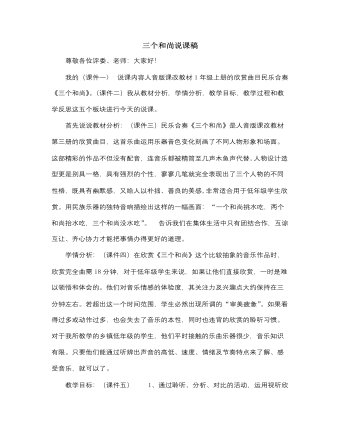
人音版小学音乐一年级上三个和尚说课稿
3.请几组同学表演这几个的场面,其他同学做评委,从模仿表演中享受学习音乐的快乐。五.课堂小结 (阶段目标:以“我的收获”(课件十)帮助学生总结所学内容,知道音乐中,不同的音乐要素可以表现不同的人物、场面)课后反思:(课件十一)在本节音乐欣赏教学中,我坚持以“听”为核心(因为音乐是一门听觉艺术),让学生“带着问题听”、“想着听”、“动着听”、“演着听”等多元化的“听”的形式。一系列“听”的任务不仅提高学生的注意力,而且提高学生“听”的兴趣与“听”的质量。而且我创造和谐的课堂气氛,积极引导学生把对音乐的内心感受大胆地用语言表达出来,让学生主动参与音乐快乐学习的实践中去,创建出有利于学生发展的生动活泼的音乐课堂情景,让学生的了解音乐,感受音乐,融入音乐。
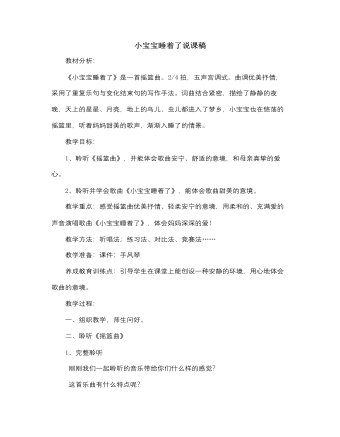
人音版小学音乐一年级下小宝宝睡着了说课稿
三、聆听、表演《小宝宝睡着了》 1、聆听歌曲启发学生说说听到歌曲时感受到了什么?2、复听,跟着歌曲,轻柔地拍节拍。 3、听琴声逐句学唱歌曲。 4、指导学生用连贯、轻柔的声音,唱准、唱好歌曲。 5、重点引导学生说说结尾的处理方式——对比练习,看哪一种方法更恰当 6、引导学生用自己创作的方式为歌曲伴奏、伴舞。 四、小结。 教学反思:一年级课堂上会有一些学生在上课的时候出现喊唱的现象,我在歌曲处理这一环节对歌曲的意境作了这样的描述:静静的夜晚,天上的星星睡了、月亮睡了、地上的鸟儿、虫儿也都进入了梦乡,小宝宝也在悠荡的摇篮里,听着妈妈甜美的歌声,渐渐入睡了。同学们妈妈哄宝宝睡觉唱歌的声音应该是欢快的,还是轻柔的?经过我的描绘和讲解学生理解了在演唱摇篮曲时应该用轻柔的声音,要把每一句都连贯的唱起来,不仅句与句之间要连贯,第一、第二段也要衔接紧凑,轻轻的哼唱出来,体会妈妈哄小宝宝睡觉时是多么的温柔。
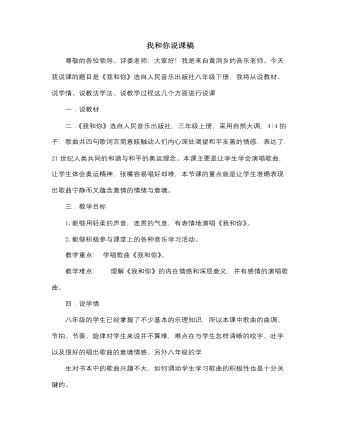
人音版小学音乐三年级上册我和你说课稿
6.欣赏第二版本。 师:关于歌曲《我和你》,还有一个鲜为人知的小故事,歌曲的原唱其实另有他人。最初作曲家陈其钢选了非常有实力的两位歌坛新秀来演唱,导演张艺谋认为一定要选择知名度很高的歌手,两人还因此大吵了一架,据说原唱的歌声更加轻盈,更加动听,你们想听一听吗?7.演唱常石磊版。 师:大家知道了,为了更好地表现出这首歌的宁静简单的气质,我们的演唱要最大限度地轻盈、柔和,就像天使的声音一样纯净。下面该轮到同学们来演唱了。注意眼睛看老师的手势,控制好气息,有表情地演唱。8.钢琴伴奏演唱。师:通过演唱,同学们肯定都感受到了这首歌曲的动人之处。下面我想请同学们站起来,想象我们来到宽敞的户外,把心放在天地间,让我们跟着钢琴伴奏,用我们纯净美妙的歌声来演绎。
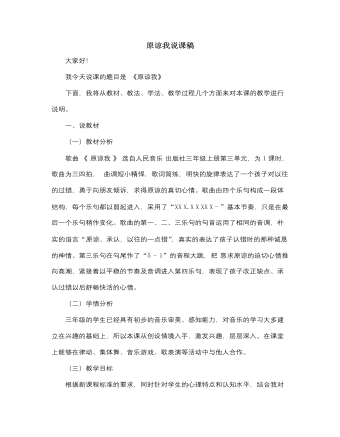
人音版小学音乐三年级上册原谅我说课稿
4)进行分组练唱、对唱、全体学生合唱。在分组练唱过程中,我将在学生中间进行单独指导,询问他们学习的难点并与学生一起解决,然后适当提问个别学生。通过小组唱、对唱等形式进行演唱评比,提高学生演唱热情。这样,不仅加深了学生对歌曲的熟悉程度,还为学生更好地理解歌曲做了铺垫。5)表演唱,通过表演,不仅展示了学生个性、激发学生的创造力、表现力,而且再次加深了学生对歌曲情感的理解和体验。(三)第三环节——拓展延伸通过对歌曲节拍节奏的改编,让学生感受到得到好朋友原谅后又能快乐的游戏的情绪变化,感受到与好朋友在一起是一件幸福快乐的事。本方案的设计,力求体现以人为本的思想,着眼于学生的主动发展,通过充分的音乐实践,培养学生的能力,提高音乐素养;培养学生的合作意识、探究精神。从目标的提出、到过程的安排、学习方法的确定、乃至学习成果的呈现,都让学生有更大的自主性、更多的实践性。
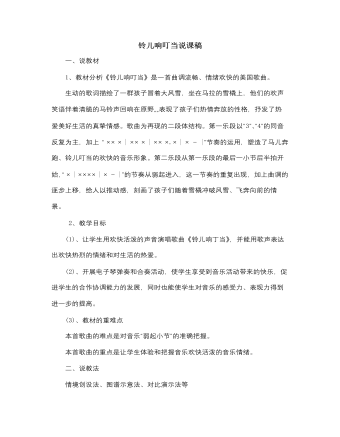
人音版小学音乐五年级下册铃儿响叮当说课稿
结合我们学校的教学条件和我自身会弹琴的优势,我还设计了课堂弹奏活动,激励学生练习好了参加圣诞联欢晚会给大家表演节目。 我把第一段的乐谱进行了简化节奏让学生弹奏,在弹奏基本完成后还设计了学生边唱边弹,并且分组让学生用电子琴自带的的打击乐器进行合奏练习,让学生在学唱的同时更加深入的体会音乐欢快活泼的节奏特点,同时让学生感受合奏的整体的音响效果,培养了学生的动手能力和集体合作能力。 六、总结 本课以歌曲《铃儿响叮当》为主要内容,听、唱、弹等教学环节都围绕他展开,各教学环节的设计易于统一,各项活动的设计均以音乐审美为核心,教学中关注段落的划分,注重引导学生的参与,体验,引导学生积极探索创造学习,展现音乐的节奏之美。
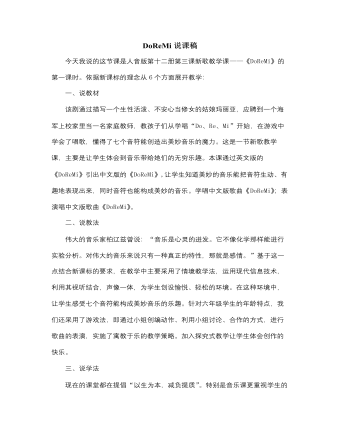
人音版小学音乐六年级下册DoReMi说课稿
1.通过欣赏《DO RE Mi》的影片,调动学生的积极性,增强学生学习新歌的兴趣。2.了解电影。任何一首歌曲都有着不一样的故事,通过文字简介,能够帮助学生深入歌曲的学习,升华表演的情绪。然后通过聆听歌曲《DO RE MI》,师范唱,生听唱,师指导唱的形式来帮助学生继续领略音乐的魅力。7.音乐游戏。不仅将学生分成七个小组跟琴演唱,还让学生根据伴奏完成歌曲接龙,充分体现了学生在课堂中的主体性。8.拓展开发。通过了解柯尔文手势,电影的背景资料和歌曲《孤独的牧羊人》的欣赏,提高学生的能力。第二环节既是这节课的重点,也是难点,通过引导学生运用手势音阶和肢体语言来表演歌曲《DoReMi》,又通过小组合作的方式突破难点。最后小结,简单地总结了同学们的表演让所有人感受到音乐带给我们的无穷乐趣,七个音乐字母构成了美妙的音乐,最后在美妙的音乐中结束了这节课!
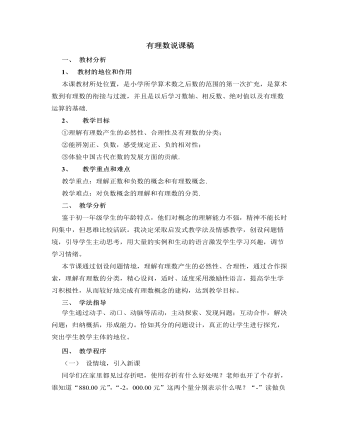
北师大初中数学七年级上册有理数说课稿
1、 教材的地位和作用本课教材所处位置,是小学所学算术数之后数的范围的第一次扩充,是算术数到有理数的衔接与过渡,并且是以后学习数轴、相反数、绝对值以及有理数运算的基础.2、 教学目标①理解有理数产生的必然性、合理性及有理数的分类;②能辨别正、负数,感受规定正、负的相对性;③体验中国古代在数的发展方面的贡献.3、 教学重点和难点教学重点:理解正数和负数的概念和有理数概念.教学难点:对负数概念的理解和有理数的分类.二、 教学分析鉴于初一年级学生的年龄特点,他们对概念的理解能力不强,精神不能长时间集中,但思维比较活跃。我决定采取启发式教学法及情感教学,创设问题情境,引导学生主动思考,用大量的实例和生动的语言激发学生学习兴趣,调节学习情绪。
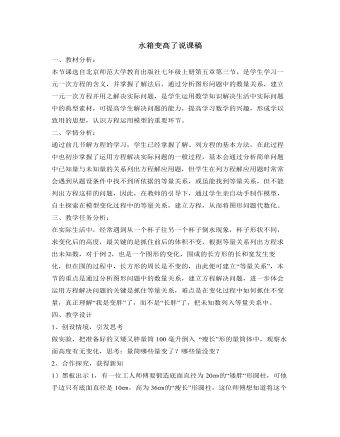
北师大初中数学七年级上册水箱变高了说课稿
一、教材分析:本节课选自北京师范大学教育出版社七年级上册第五章第三节,是学生学习一元一次方程的含义,并掌握了解法后,通过分析图形问题中的数量关系,建立一元一次方程并用之解决实际问题,是学生运用数学知识解决生活中实际问题中的典型素材,可提高学生解决问题的能力,提高学习数学的兴趣,形成学以致用的思想,认识方程运用模型的重要环节。二、学情分析:通过前几节解方程的学习,学生已经掌握了解、列方程的基本方法,在此过程中也初步掌握了运用方程解决实际问题的一般过程,基本会通过分析简单问题中已知量与未知量的关系列出方程解应用题,但学生在列方程解应用题时常常会遇到从题设条件中找不到所依据的等量关系,或虽能找到等量关系,但不能列出方程这样的问题,因此,在教师的引导下,通过学生亲自动手制作模型,自主探索在模型变化过程中的等量关系,建立方程,从而将图形问题代数化。
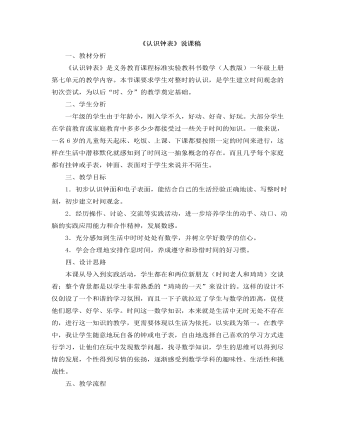
小学数学人教版一年级上册《认识钟表》说课稿
一、教材分析《认识钟表》是义务教育课程标准实验教科书数学(人教版)一年级上册第七单元的教学内容。本节课要求学生对整时的认识,是学生建立时间观念的初次尝试,为以后“时、分”的教学奠定基础。二、学生分析一年级的学生由于年龄小,刚入学不久,好动、好奇、好玩。大部分学生在学前教育或家庭教育中多多少少都接受过一些关于时间的知识。一般来说,一名6岁的儿童每天起床、吃饭、上课、下课都要按照一定的时间来进行,这样在生活中潜移默化就感知到了时间这一抽象概念的存在。而且几乎每个家庭都有挂钟或手表,钟面、表面对于学生来说并不陌生。三、教学目标 1.初步认识钟面和电子表面,能结合自己的生活经验正确地读、写整时时刻,初步建立时间观念。 2.经历操作、讨论、交流等实践活动,进一步培养学生的动手、动口、动脑的实践应用能力和合作精神,发展数感。
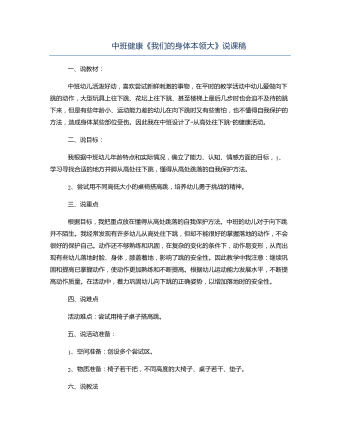
中班健康《我们的身体本领大》说课稿
根据目标,我把重点放在懂得从高处跳落的自我保护方法。中班的幼儿对于向下跳并不陌生。我经常发现有许多幼儿从高处往下跳,但却不能很好的掌握落地的动作,不会很好的保护自己。动作还不够熟练和巩固,在复杂的变化的条件下,动作易变形,从而出现有些幼儿落地时脸、身体,膝盖着地,影响了跳的安全性。因此教学中我注意:继续巩固和提高已掌握动作,使动作更加熟练和不断提高。根据幼儿运动能力发展水平,不断提高动作质量。在活动中,着力巩固幼儿向下跳的正确姿势,以增加落地时的安全性。
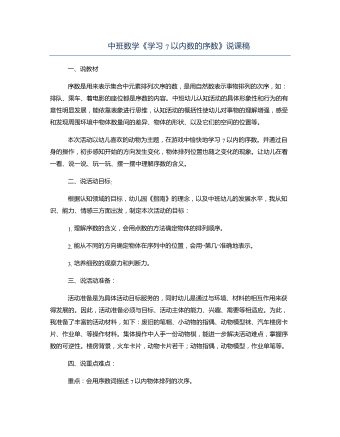
中班数学《学习7以内数的序数》说课稿
序数是用来表示集合中元素排列次序的数,是用自然数表示事物排列的次序,如:排队、乘车、着电影的座位都是序数的内容。中班幼儿认知活动的具体形象性和行为的有意性明显发展,能依靠表象进行思维,认知活动的概括性使幼儿对事物的理解增强,感受和发现周围环境中物体数量间的差异、物体的形状、以及它们的空间的位置等。本次活动以幼儿喜欢的动物为主题,在游戏中愉快地学习7以内的序数。并通过自身的操作,初步感知开始的方向发生变化,物体排列位置也随之变化的现象。让幼儿在看一看、说一说、玩一玩、摆一摆中理解序数的含义。

